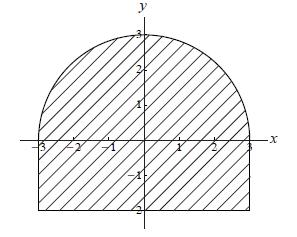Science:Math Exam Resources/Courses/MATH101/April 2013/Question 05 (b)
{{#incat:MER QGQ flag|{{#incat:MER QGH flag|{{#incat:MER QGS flag|}}}}}}
• Q1 (a) • Q1 (b) • Q1 (c) • Q2 (a) • Q2 (b) • Q2 (c) • Q3 (a) • Q3 (b) • Q3 (c) • Q4 (a) • Q4 (b) • Q5 (a) • Q5 (b) • Q6 (a) • Q6 (b) • Q7 (a) • Q7 (b) • Q8 • Q9 (a) • Q9 (b) • Q10 (a) • Q10 (b) • Q11 • Q12 (a) • Q12 (b) • Q12 (c) •
Question 05 (b) |
|---|
|
Full-Solution Problems. In questions 4–12, justify your answers and show all your work. If a box is provided, write your final answer there. Unless otherwise indicated, simplification of numerical answers is required in these questions. Find the centroid of the region below, which consists of a semicircle of radius 3 on top of a rectangle of width 6 and height 2. |
|
Make sure you understand the problem fully: What is the question asking you to do? Are there specific conditions or constraints that you should take note of? How will you know if your answer is correct from your work only? Can you rephrase the question in your own words in a way that makes sense to you? |
|
If you are stuck, check the hint below. Consider it for a while. Does it give you a new idea on how to approach the problem? If so, try it! |
Hint |
|---|
|
Try using physical intuition to estimate an answer. You may even be able to predict one of the coordinates precisely! |
|
Checking a solution serves two purposes: helping you if, after having used the hint, you still are stuck on the problem; or if you have solved the problem and would like to check your work.
|
Solution |
|---|
|
Note that we do not need to know the density, since it cancels out later. First, we calculate the area by adding the areas of the rectangle and semicircle: We identify the endpoints of the integral as , the top function as and the bottom function as . Then by (odd) symmetry. Alternatively, you could argue from a physical point of view that the -coordinate of the centre of mass must be 0. By (even) symmetry, |
{{#incat:MER CT flag||
}}


![{\displaystyle [-3,3]}](https://wiki.ubc.ca/api/rest_v1/media/math/render/svg/3a869f6f7ff84a95f888c6b8705e2465ba21960e)




![{\displaystyle \displaystyle {\begin{aligned}{\overline {y}}&={\frac {1}{A}}\int _{-3}^{3}{\frac {1}{2}}[(3^{2}-x^{2})-2^{2})]\ dx\\&={\frac {1}{2A}}\int _{-3}^{3}(5-x^{2})\ dx\\&={\frac {1}{2A}}\cdot 2\int _{0}^{3}(5-x^{2})\ dx\\&={\frac {1}{A}}\int _{0}^{3}(5-x^{2})\ dx\\&={\frac {1}{A}}\left.\left(5x-{\frac {x^{3}}{3}}\right)\right|_{0}^{3}\ dx\\&={\frac {1}{A}}(15-9)\\&={\frac {6}{12+{\tfrac {9}{2}}\pi }}\\&={\frac {4}{8+3\pi }}\end{aligned}}}](https://wiki.ubc.ca/api/rest_v1/media/math/render/svg/e8ff7bde8be3b9b9b06dd7d2d550c9f4e77ecb4e)
